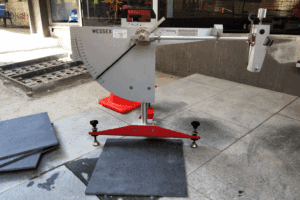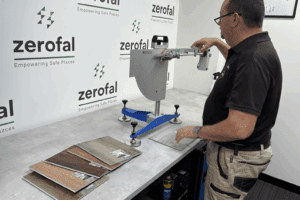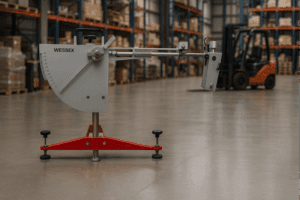Borderline Results: Why Interpretation Matters
NATA Accreditation and experience matters
- Borderline slip resistance results occur both at numerical thresholds and when standards are applied differently by location.
- A surface may technically meet AS 4586:2013 or AS 4663:2013 but still fail when slope correction or HB198-2014 interpretations are applied.
- Regulators and insurers apply the stricter interpretation, so borderline outcomes should be treated as a warning.
Slip resistance testing provides clear classifications, yet results are not always straightforward. Some fall into what can best be described as borderline territory. These results are particularly important for builders, manufacturers, and facility managers to understand. A surface that seems compliant under one interpretation may fail under another, with significant implications for liability and compliance.
Numerical Borderline Results
AS 4586:2013 requires rounding to the nearest 0.05 for dry floor friction results and to the nearest whole number for wet pendulum outcomes. A mean coefficient of friction of 0.39 may look acceptable, but under the standard it becomes D0, not D1. Similarly, a wet pendulum mean of 34 places a surface at the lower limit of P2. However, classification depends not only on the number but also on which slider is used: Slider 96 (Four S rubber) applies to smoother indoor surfaces, while Slider 55 (TRL rubber) is often used for outdoor or wet barefoot areas. A result that passes with one slider may not meet the threshold with the other, and a single run below the required tolerance can still lead to a downgrade. These are not technicalities; they determine whether a surface is classified as compliant or non-compliant.
Interpretive Borderline Results
Slip ratings are not applied in isolation—they depend on where and how a surface is used. HB198:2014 sets different minimums for lobbies, bathrooms, kitchens, ramps, and external pavements. A tile rated P3 may be suitable for a hotel lobby but fail on an external ramp, where P4 is required. The challenge is that interpretation is involved: one tester may classify an area under the building line as “outdoor,” another as “transitional.” These distinctions change the compliance threshold. That’s why results must come from a NATA-accredited tester who understands both the standard and the way your space is used. Experience matters; relying only on a manufacturer’s rating leaves builders or designers to decide what P-rating applies, creating risk if the wrong classification is assumed.
The Risk of Minimum Compliance
Borderline results expose projects to risk because regulators and insurers default to the stricter classification. A surface that only clears the lowest possible threshold offers little protection in the event of a dispute or claim. For this reason, treating borderline outcomes as compliant is poor practice.
Best Practice
Where results fall near thresholds, retesting is advisable. Testing multiple samples from a batch reduces the risk of false confidence. If a surface sits on the edge between classifications, it is safer to specify or treat it to the higher standard.
Borderline results highlight why slip resistance testing is more than a numbers exercise. Interpretation matters. The safest approach is to adopt conservative readings, retest when necessary, and always align classifications with the specific requirements of the intended location.
Borderline results can create uncertainty
Zerofal provides clear interpretation, guidance, and NATA-accredited reports to ensure compliance is defensible
Explore more

Colour, Grit and Surface Finish: How Subtle Differences Change Slip Ratings (AS 4586:2013)
Colour, grit and finish change slip resistance. Learn why P-ratings vary across tile ranges and coatings

Why One Slip Test Isn’t Enough for Product Lines (AS 4586:2013)
Slip resistance varies across colours and finishes. Learn why one AS 4586 test cannot certify an entire product line.

Industrial Slip Resistance: Dust, Boots & Coating Drift (AS 4663:2013)
: Industrial floors change fast. Learn how dust, coatings and machinery reduce slip resistance and why AS 4663 onsite testing is essential.
